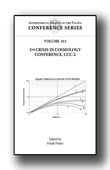| |
| Title: |
2nd Crisis in Cosmology Conference, CCC-2
|

|
| Volume: |
413
|
Year: |
2009
|
View this Volume on ADS
|
| Editors: |
Potter, Frank
|
| Synopsis: |
The papers in this volume are based upon talks given at the 2nd Crisis in Cosmology Conference (CCC-2) held 7-11 September 2008 in Port Angeles, Washington, USA, and sponsored by the Meta Research Organization (MRI), the International Academy for Cosmological Studies (IACS) and the Virtual Institute of Rational Astrophysics (VIRA). As a continuation of the 1st Crisis in Cosmology Conference (CCC-1) held in 2005 in Monção, Portugal, the contributions herein emphasize alternative interpretations of the astrophysical and cosmological data collected from numerous sources, including satellites and ground-based telescopes.
The conference began with investigations into the reality of cosmic expansion and the possible origins of the background microwave radiation, including interpreting hydrogen cloud separation data, utilizing the Tolman surface brightness test of galaxies, searching for time dilation in the quasar light curves, and examining the limits of LCDM cosmology. Presentation on the properties of quasar redshifts, the evolution of large scale structures, and the physics ground rules for evaluating alternative cosmologies followed, as well as discussion of several alternative cosmology proposals based upon familiar physical principles and recent data. Some new alternative redshift mechanisms involving novel scattering processes near starts and in the intergalactic medium leading to the Hubble relationship were discussed. Dark matter and dark energy alternatives were also proposed. The final paper presents two unique diagrams predicting the angular distance as a function of redshift (reproduced on the front cover) and the luminosity distance as a function of redshift for 12 cosmological models so that the definitive predictions of these cosmologies can be seen in comparison to the standard LCDM cosmology. The accumulation of more data in the near future should enable researchers to distinguish which cosmological model agrees best with the empirical evidence.
|
| ISBN: |
978-1-58381-706-3
|
eISBN:
|
978-1-58381-707-0
|
| Paper Title |
Page |
Authors |
|
| |
| Front Matter |
1 |
Potter, Frank |
| Photograph of Participants |
2 |
Potter, Frank |
| Part 1. Reality of Cosmic Expansion |
| |
| Hydrogen Cloud Separation as Direct Evidence of the Dynamics of the Universe |
3 |
Ashmore, L. |
| Tolman Test from z = 0.1 to z = 5.5: Preliminary Results challenge the Expanding Universe Model |
12 |
Lerner, E. J. |
| Time Dilation in Quasar Light Curves |
24 |
Hawkins, M. R. S. |
| Part 2. Origin of Microwave Radiation |
| |
| The Cosmic Microwave Background Radiation does NOT prove that the Hot Big Bang Theory is Correct |
39 |
Bligh, B. R. |
| Re-evaluation of the Cosmic Microwave Background (CMB) |
47 |
Haynes, R. |
| Part 3. Quasi-Stellar Objects |
| |
| Physical Association and Periodicity in Quasar Families |
61 |
Fulton, C.; Arp, H. |
| A Cluster of High Redshift Quasars with Apparent Diameter 2.3 Degrees |
66 |
Arp, H.; Fulton, C. |
| Quasar Additional Intrinsic Redshift Mechanism?? |
73 |
Gallo, C. F. |
| Part 4. Large-Scale Structure |
| |
| Fourier Analysis of the Large Scale Spatial Distribution of Galaxies in the Universe |
77 |
Hartnett, J. G. |
| Survey of Evidence for Top-Down versus Bottom-Up Evolution of Structure on Various Scales |
98 |
Schmitz, H. A. |
| A Review of Anomalous Redshift Data |
109 |
Ratcliffe, H. |
| Does the Mandelbrot Set Offer Clues to the Cosmological Evolution of Form? |
116 |
Dickau, J. J. |
| Part 5. Methods for Selecting Alternative Cosmologies |
| |
| The Changing Cosmology Narrative |
125 |
Eastman, T. E. |
| Cosmological Physics Ground Rules and How to Evaluate Cosmologies |
128 |
Dilworth, D. J. |
| Cosmology Without Finality |
135 |
Mahootian, F. |
| Mathematical Theory Of Cosmological Redshift in a Static Lobachevskian Universe |
145 |
von Brzeski, J. G.; von Brzeski, V. |
| A Solution to the Cosmic Conundrum including Cosmological Constant and Dark Energy Problems |
152 |
Singh, A. |
| Quasi-Steady State Cosmology |
164 |
Vishwakarma, R. G. |
| Plasma-Redshift Cosmology: A Review |
169 |
Brynjolfsson, A. |
| Time as a Key to Cosmology: Theory of Time beyond the Standard Model |
190 |
Poliakov, E. S. |
| Nucleosynthesis in Plasma-Redshift Cosmology |
209 |
Brynjolfsson, A. |
| Part 7. Hubble Relationship Alternatives |
| |
| The Conflict between Realism and the Scalar Potential in Electrodynamics |
221 |
Roscoe, D. F. |
| Coherent Spectroscopy of Supernova Remnant 1987A |
233 |
Moret-Bailly, J. |
| Does Cosmological Scale Expansion Explain the Universe? |
244 |
Masreliez, C. J. |
| Hubble's Cosmology: From a Finite Expanding Universe to a Static Endless Universe |
255 |
Assis, A. K. T.; Neves, M. C. D.; Soares, D. S. L. |
| Optical Forces as a Redshift Mechanism: the "Spectral Transfer Redshift'' |
268 |
Marmet, L. |
| Part 8. Dark Matter and Dark Energy Alternatives |
| |
| Conformal Gravity Challenges String Theory |
279 |
Mannheim, P. D. |
| A Thin-Disk Gravitational Model for Galactic Rotation |
289 |
Gallo, C. F.; Feng, J. Q. |
| Does Dark Energy Signal a Wrong Physics? |
304 |
Vishwakarma, R. G. |
| Survey of Redshift Relationships for the Proposed Mechanisms at the 2nd Crisis in Cosmology Conference |
315 |
Marmet, L. |
| Back Matter |
325 |
Potter, Frank |
|
|


